Ore Processing Technologies Applied to Industrial Waste Decontamination: A Case Study
Abstract
:1. Introduction
2. Material and Methods
3. Results
3.1. Characterization for Decontamination
3.2. Attrition by Stirring
3.3. Attrition by Light Milling
4. Discussion
5. Conclusions
Author Contributions
Funding
Data Availability Statement
Conflicts of Interest
References
- Luthra, S.; Mangla, S.K.; Sarkis, J.; Tseng, M. Resources melioration and the circular economy: Sustainability potentials for mineral, mining and extraction sector in emerging economies. Resour. Policy 2022, 77, 102652. [Google Scholar] [CrossRef]
- Santana Barros, K.; Schaeffer Vielmo, V.; Garrido Moreno, B.; Riveros, G.; Cifuentes, G.; Moura Bernardes, A. Chemical composition data of the main stages of copper production from sulphide minerals in Chile: A review to assist circular economy studies. Minerals 2021, 12, 250. [Google Scholar] [CrossRef]
- European Commission. Circular Economy Action Plan. 2021. Available online: https://ec.europa.eu/environment/strategy/circular-economy-action-plan_es (accessed on 20 January 2022).
- Madanhiure, I.; Mbohwa, C. Achieving Environmental Performance through Design for Environment (DFE) Process in Foundry Operations. In In 13th Global Conference on Sustainable Manufacturing—Decoupling Growth from Resource Use; Elsevier: Amsterdam, The Netherlands, 2016; Volume 40, pp. 121–126. [Google Scholar] [CrossRef] [Green Version]
- Powell, T.C. Total quality management as competitive advantage: A review and empirical study. Strateg. Manag. J. 1995, 16, 15–37. [Google Scholar] [CrossRef]
- Bilal, H.; Yaqub, M.; Rehman SK, U.; Abid, M.; Alyousef, R.; Alabduljabbar, H.; Aslam, F. Performance of foundry sand concrete under ambient and elevated temperatures. Minerals 2019, 12, 2645. [Google Scholar] [CrossRef] [Green Version]
- Alfonso, P.; Tomasa, O.; Garcia-Valles, M.; Tarragó, M.; Martínes, S.; Esteves, H. Potential of tungsten tailings as glass raw materials. Mater. Lett. 2018, 228, 456–458. [Google Scholar] [CrossRef]
- Baowei, L.; Leibo, D.; Xuefeng, Z.; Xiaolin, J. Structure and performance of glass-ceramics obtained by Bayan-Obo tailing and fly ash. J. Non-Cryst. Solids 2013, 280, 103–108. [Google Scholar] [CrossRef]
- Priyadarshini, M.; Giri, J.P. Use of recycled foundry sand for the development of green concrete and its quatification. J. Build. Eng. 2022, 52, 104474. [Google Scholar] [CrossRef]
- Khan, M.M.; Mahajani, S.M.; Jadhav, G.N.; Vishwakarma, R.; Malgaonkar, V.; Mandre, S. Mechanical and thermal methods for reclamation of waste foundry sand. J. Environ. Manag. 2021, 279, 111628. [Google Scholar] [CrossRef]
- Luo, H.; Lin, D.; Chung, M.; Chen, L. Waste Foundry Sand reused as Clay Replacement for Tile Manufacture. Int. J. Transp. Sci. Technol. 2014, 3, 339–352. [Google Scholar] [CrossRef] [Green Version]
- Deng, A.; Tikalsky, P.J. Geotechnical and leaching properties of flowable fill incorporating waste foundry sand. Waste Manag. 2007, 28, 2161–2170. [Google Scholar] [CrossRef] [PubMed] [Green Version]
- Vijayakumar, S.; Srinivasan, M.V.; Govindaraju, M. Reduction of waste in furan molding process from cast iron foundry. Mater. Today Proc. 2021, 46, 5032–5035. [Google Scholar] [CrossRef]
- Sarkar, A.D. Sand reclamation. In Mould & Core Material for the Steel Foundry; Elsevier: Amsterdam, The Netherlands, 1967; pp. 102–109. [Google Scholar]
- Khan, M.M.; Singh, M.; Mahajani, S.M.; Jadhav, G.N.; Mandre, S. Reclamation of used green sand in small scale foundries. J. Mater. Process. Technol. 2018, 255, 559–569. [Google Scholar] [CrossRef]
- Zanetti, M.C.; Fiore, S. Foundry processes: The recovery of green moulding sands for core operations. Resour. Conserv. Recycl. 2003, 38, 243–254. [Google Scholar] [CrossRef]
- Jones, T.J.; Russell, J.K. Attrition in the kimberlite system. Mineral. Petrol. 2019, 112, 491–501. [Google Scholar] [CrossRef] [Green Version]
- Petavy, F.; Ruban, V.; Conil, P.; Viau, J.Y. Attrition efficiency in the decontamination of stormwater sediments. Appl. Geochem. 2009, 24, 153–161. [Google Scholar] [CrossRef]
- Puvvada, S.; Thomson, P.; Miller, J.D. Dolomite rejection from a crushed Pebble phosphate by attrition scrubbing. Miner. Eng. 2019, 143, 105932. [Google Scholar] [CrossRef]
- Kotsur, B.; Berry, R.; Zigan, S.; García-Triñanes, P.; Bradley, S.A. Particle attrition mechanisms, their characterization, and application to horizontal lean phase pneumatic conveying systems: A review. Powder Technol. 2018, 334, 76–105. [Google Scholar] [CrossRef]
- Kim, J.Y.; Ellis, N.; Lim, C.J.; Grace, J.R. Attrition of binary mixtures of solids in a jet attrition unit. Powder Technol. 2019, 352, 445–452. [Google Scholar] [CrossRef]
- Stražišar, J.; Seselj, A. Attrition as a process of comminution and separation. Powder Technol. 1999, 105, 205–209. [Google Scholar] [CrossRef]
- El-Midany, A.A.; Selim, A.Q.; Ibrahim, A.S. Effect of celestine-calcite mineralogy on their separation by attrition scrubbing. Part. Sci. Technol. 2011, 29, 272–284. [Google Scholar] [CrossRef]
- Schaaff, F.; Schneider, M.; Neesse, T. Intensifying the attrition of mineral waste in stirrer mills. Int. J. Miner. Process. 2004, 74S, S294–S298. [Google Scholar] [CrossRef]
- Neesse, T.; Schaaff, F.; Tiefel, H. High performance attrition in stirred mills. Miner. Eng. 2004, 17, 1163–1167. [Google Scholar] [CrossRef]
- Parapari, P.S.; Parian, M.; Rosenkranz, J. Breakage process of mineral processing comminution machines—An approach to liberation. Adv. Powder Technol. 2020, 31, 3669–3685. [Google Scholar] [CrossRef]
- Sabour, M.R.; Akbari, M.; Dezvareh, G. Utilization of colour change and image processing to evaluate the Waste Foundry Sand reclamation level. J. Mater. Res. Technol. 2020, 9, 1025–1031. [Google Scholar] [CrossRef]
- Svoboda, S. Foundry Sand Reclamation; CMP report 90-6; CMO The EPRI Center for Materials Production: Pittsburgh, PA, USA, 1990. [Google Scholar]
- Winkler, E.; Bol’shakov, A. Characterization of foundry sand waste. In Chelsea Center for Recycling and Economic Development; University of Massachusetts: Chelsea, MA, USA, 2000. [Google Scholar]
- ASTM Standard ASTM D7348-07; Standard Test Method for Sieve Analysis of Fine and Coarse Aggregates. ASTM International: West Conshohocken, PA, USA, 2015; p. C136-06.
- Kumar, A.; Holuszko, M.E.; Janke, T. Determination of loss on ignition test conditions for nonmetal fraction from processed waste printed circuit boards. Resour. Conserv. Recycl. 2020, 163, 105105. [Google Scholar] [CrossRef]
- Bond, F.C. Metal wear in crushing and grinding. Chem. Eng. Prog. 1964, 60, 90–93. [Google Scholar]
- Kalman, H.; Goder, D. Design criteria for particle attrition. Adv. Powder Technol. 1998, 9, 153–167. [Google Scholar] [CrossRef]
- Gupta, A.; Yan, D. Mineral Processing Design and Operation; Elsevier: Amsterdam, The Netherlands, 2006. [Google Scholar]
- Bayley, R.W.; Biggs, C.-A. Characterisation of an attrition scrubber for the removal of high molecular weight contaminants in sand. Chem. Eng. 2005, 111, 71–79. [Google Scholar] [CrossRef]
- Grant, E.; Kalman, H. Fatigue analysis of particle attrition in a rotating drum. Part. Part. Syst. Charact. 2001, 8, 64–69. [Google Scholar] [CrossRef]
- Altun, O.; Altun, D. Estimation of mineral liberation distribution functions to be used in modelling of impact and attrition milling. Miner. Eng. 2021, 173, 107236. [Google Scholar] [CrossRef]
- Tittarelli, F. Waste foundry Sand, Waste and Supplementary Cementitious Materials in Concrete; Woodhead Publishing Series in Civil and Structural Engineering; Woodhead Publishing: Sawston, UK, 2018; pp. 121–147. ISBN 9780081021569. [Google Scholar]
- Vereș, A.Ș. A Comparative Study between Loss on Ignition and Total Carbon Analysis on Mineralogenic Sediments. Studia UBB Geol. 2002, 47, 171–182. [Google Scholar] [CrossRef]
- De Vos, B.; Vandecasteele, B. Capability of Loss-on-Ignition as a predictor of total organic carbon in non-calcareous forest soils. Commun. Soil Sci. Plant Anal. 2005, 36, 2899–2921. [Google Scholar] [CrossRef]
- Andric, L.; Terzic, A.; Acimovic-Pavlovic, Z.; Pavlovic, L.; Petrov, M. Comparative analysis of process parameters of talc mechanical activation in centrifugal and attrition mill. Physicochem. Probl. Miner. Process. 2013, 50, 433–452. [Google Scholar]
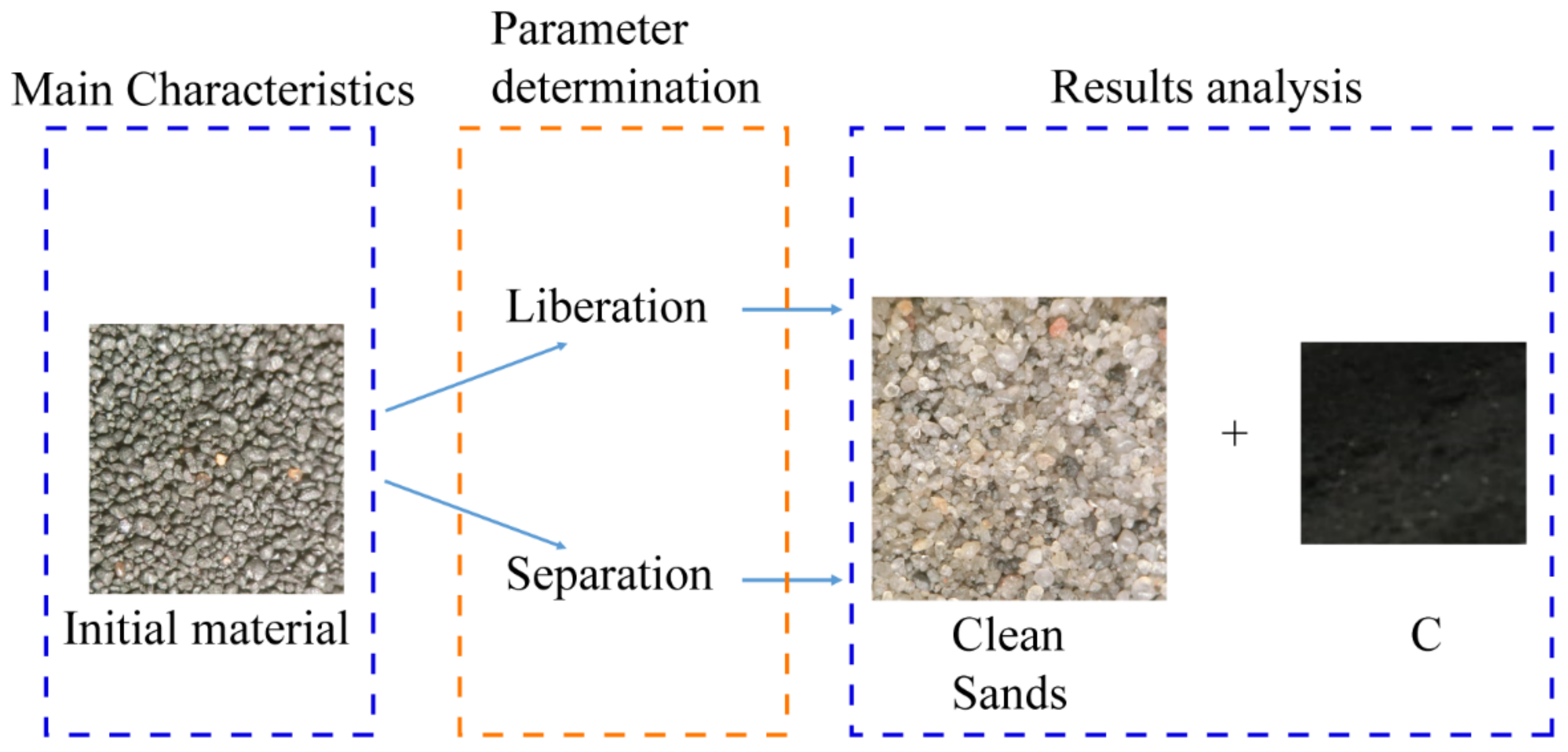
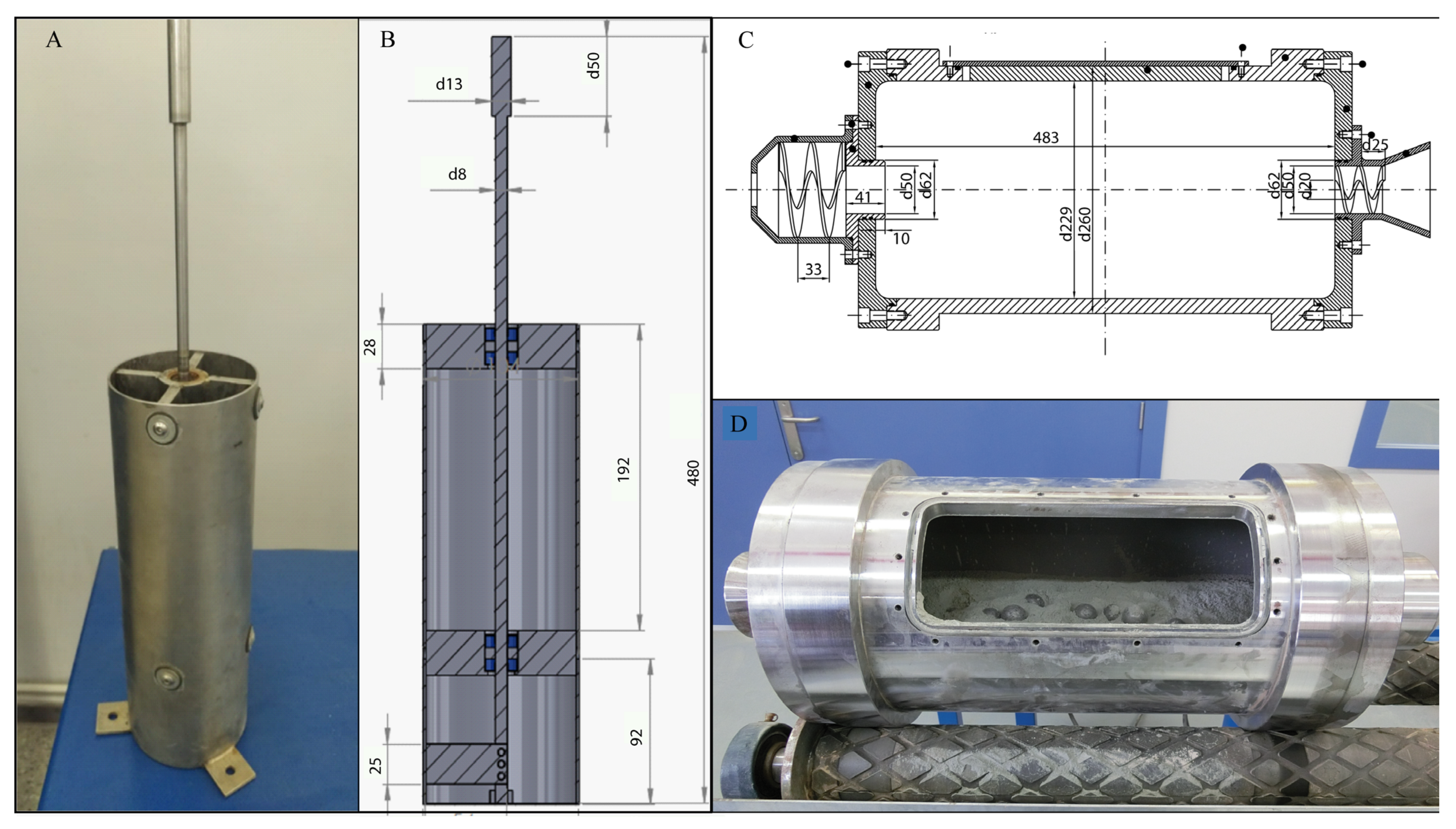


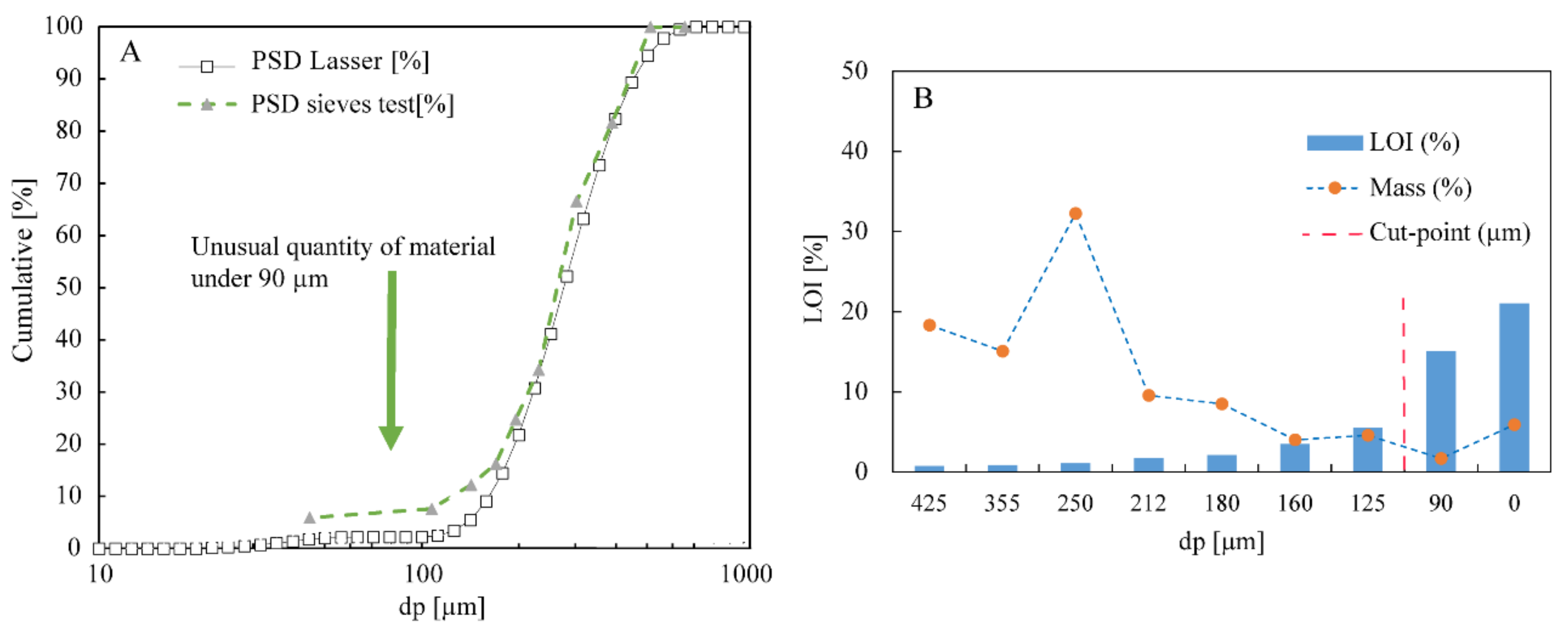



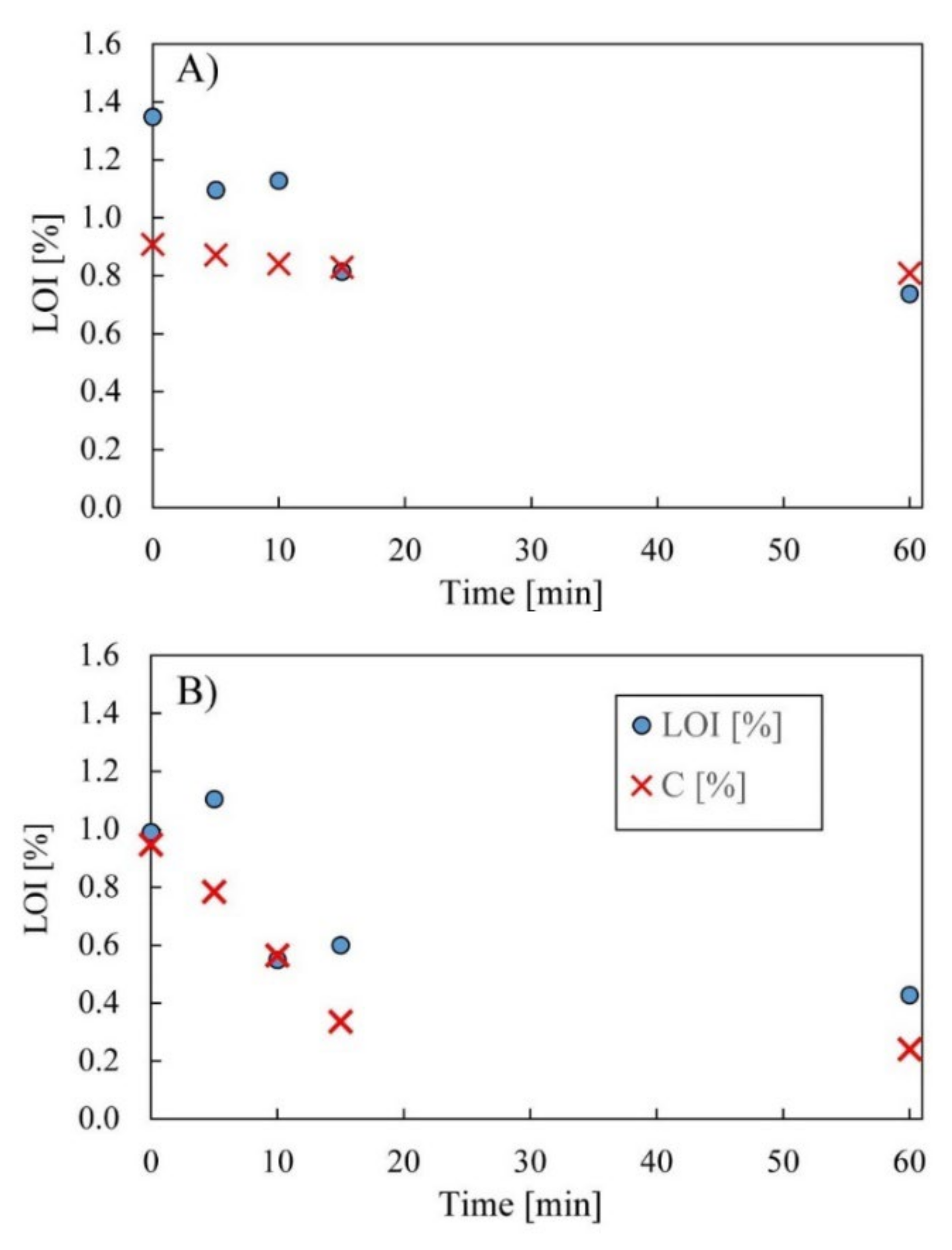
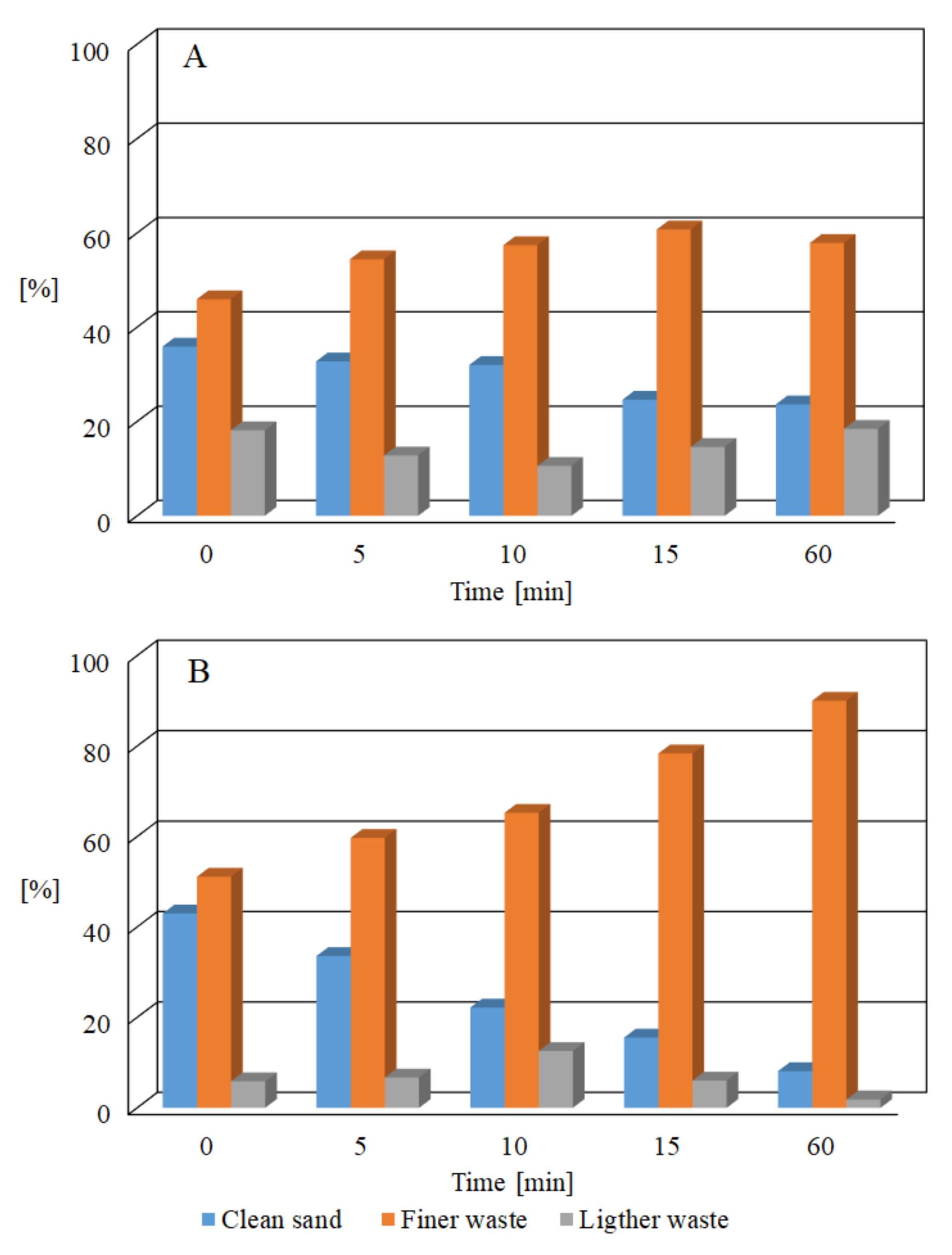

| Concept | Light Milling | Stirring | Units |
|---|---|---|---|
| Drum diameter | 0.24 | 0.24 | m |
| Power draw | 750 | 710 | W |
| Critical speed VC | 90 | N.A. | rpm |
| Operative speed | 30 | 710 | rpm |
| Grinding media charge | 4 | N.A. | kg |
| Material mass | 0.3 | 0.3 | kg |
| Water | 1 | 1 | kg |
| Solid/water ratio % w/w | 30 | 30 | % |
| Element | Waste Material | Raw Material | ||
|---|---|---|---|---|
| Coarse | Fines | Silicic Sand | Binders | |
| [%] | [%] | [%] | [%] | |
| O | 48.57 | 39.92 | 52.23 | 37.45 |
| Si | 35.10 | 23.57 | 44.32 | 21.34 |
| C | 3.87 | 16.50 | - | 21.47 |
| Others | 12.47 | 20.01 | 3.45 | 19.74 |
| Gauss-Newton Algorithm | Parameters | ||
|---|---|---|---|
| Φ1 | Φ2 | Φ3 | |
| Stirring | 0.7819 | 0.3212 | −0.1951 |
| Light milling | 0.5243 | 0.6335 | −0.1679 |
| Concept | Units | Stirring | Light Milling |
|---|---|---|---|
| Recovered clean sand | % | 85.5 | 82.4 |
| C | % | 0.8 | 0.3 |
| Energy consumption | kWh/t | 1.5 | 9.1 |
Publisher’s Note: MDPI stays neutral with regard to jurisdictional claims in published maps and institutional affiliations. |
© 2022 by the authors. Licensee MDPI, Basel, Switzerland. This article is an open access article distributed under the terms and conditions of the Creative Commons Attribution (CC BY) license (https://creativecommons.org/licenses/by/4.0/).
Share and Cite
Anticoi, H.; Moncunill, J.O.; Sampaio, C.H.; Pérez-Álvarez, R.; Malagón-Picón, B. Ore Processing Technologies Applied to Industrial Waste Decontamination: A Case Study. Minerals 2022, 12, 695. https://doi.org/10.3390/min12060695
Anticoi H, Moncunill JO, Sampaio CH, Pérez-Álvarez R, Malagón-Picón B. Ore Processing Technologies Applied to Industrial Waste Decontamination: A Case Study. Minerals. 2022; 12(6):695. https://doi.org/10.3390/min12060695
Chicago/Turabian StyleAnticoi, Hernan, Josep Oliva Moncunill, Carlos Hoffman Sampaio, Rubén Pérez-Álvarez, and Beatriz Malagón-Picón. 2022. "Ore Processing Technologies Applied to Industrial Waste Decontamination: A Case Study" Minerals 12, no. 6: 695. https://doi.org/10.3390/min12060695








